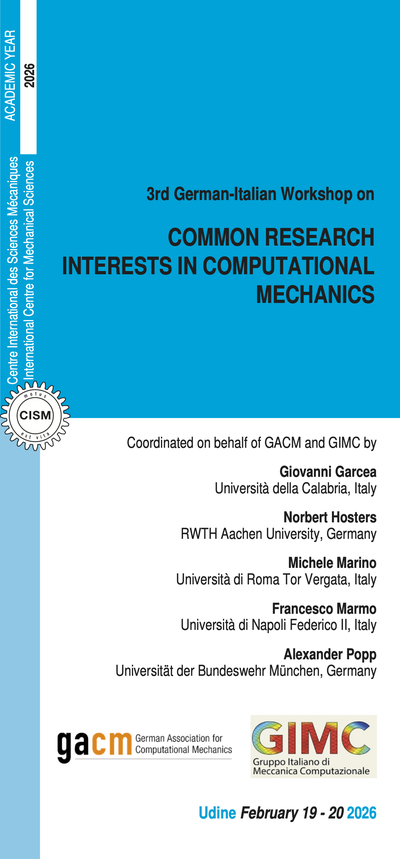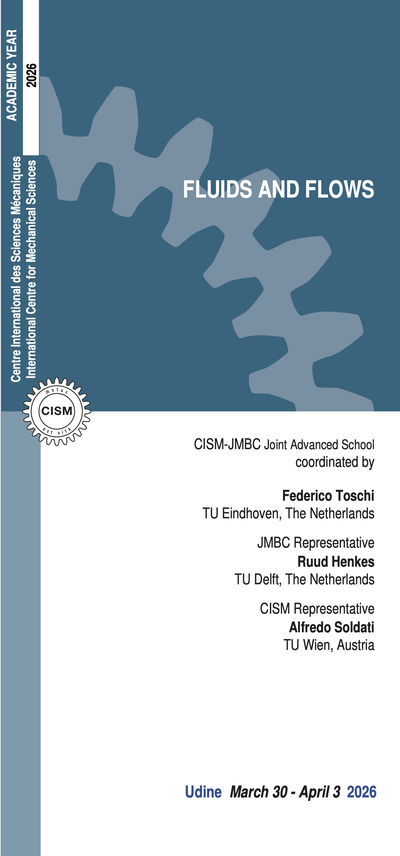The purpose of this course is to provide a carefully crafted state-of-the-art overview of the fundamental theories, established models and ongoing research related to instability and bifurcation phenomena in solids undergoing finite deformations, including the effects of electric fields and growth. The course will be organized around several complementary and interacting themes. A comprehensive overview of the continuum theory of materials subject to large deformation will be presented, including the constitutive equations of nonlinear elasticity, elastoplasticity, Cosserat solids, electroelasticity, residually stressed and fibre-reinforced materials, and growth in biological systems.
The general theory of bifurcation, instability and non-uniqueness within the framework of the continuum theory of solids will be discussed as the setting for applications to specific examples.
The equations governing linearized incremental deformation fields superimposed on a known finitely deformed configuration will be highlighted. The tensors of elastic moduli for isotropic and anisotropic materials will be derived, including their important incompressible specialization, and associated expressions for the incremental constitutive equations and boundary conditions will be provided. These are needed for the analysis of possible bifurcation of the equilibrium configuration into periodic patterns, and will be applied in order to obtain specific results for exemplary constitutive laws.
Particular applications that will be described are material, surface, interface and bending instabilities of diffuse type. The notion of strong ellipticity will be introduced, and phenomena, such as the appearance of shear bands, associated with loss of ellipticity of the governing equations will be described. Localized bifurcation phenomena will be examined in detail, including localized bulging of tubes, necking of plates, shear banding, creasing and folding. Appropriate numerical formulations will be provided in order to illustrate the solutions for a range of specific boundary-value problems.
A summary of the key equations of electroelasticity will also be given, leading to the corresponding incremental formulations of electroelasticity. In this context wrinkling of a thin film of dielectric elastomer, treated as a prototype actuator, can be generated by application of an electric potential between compliant electrodes on the surfaces of the film, leading to pull-in instability and dielectric breakdown, and therefore rendering the actuator ineffective. Thus, analysis of such instabilities will be included in the course since this is important for the design and integrity of such devices.
The methods of stability analysis have a wide applicability in the context of the mechanics of soft tissue, particularly as related to instabilities associated with growth and remodelling. In growth and development, instabilities are used constructively by nature for the formation of structures, such as in the folding of tissues to form different parts of the brain. Aspects of stability and instability that relate to growth and the possible development of pathologies will also be discussed.
The course is addressed to doctoral students and postdoctoral researchers in mechanical, civil and electrical engineering, materials science, applied physics and applied mathematics, academic and industrial researchers and practicing engineers.
M. Ben Amar, A. Goriely (2005) Growth and instability in elastic tissues. J Mech Phys Solids 53:2284-2319.
M. Ben Amar, F. Jia (2013) Anisotropic growth shapes intestinal tissues during embryo-genesis. Proc Nat Acad Sciences (PNAS) 110:10525-10530.
M. Ben Amar (2018) Creases and cracks in finite elasticity. Mech Res Commun, in press.
D. Bigoni (2012) Nonlinear Solid Mechanics - Bifurcation Theory and Material Instability. Cambridge University Press.
M. Carfagna, M. Destrade, A.L. Gower, A. Grillo (2017) Oblique wrinkles. Philos Trans A Math Phys Eng Sci 375 (2017) 20160158.
M. Destrade, I. Lusetti, R. Mangan, T. Sigaeva (2017) Wrinkles in the opening angle method. Int J Solids Struct 122:189-195.
M. Destrade, A. Ni Annaidh, C.D. Coman (2009) Bending instabilities of soft biological tissues. Int J Solids Struct 46:4322-4330.
L. Dorfmann, R.W. Ogden (2010) Nonlinear electroelasticity: incremental equations and stability. Int J Eng Sci 48:1-14.
L. Dorfmann, R.W. Ogden (2014) Instabilities of an electroelastic plate. Int J Eng Sci 77:79-101.
L. Dorfmann, R.W. Ogden (2017) Nonlinear electroelasticity: materials, continuum theory and applications. Proc R Soc A 473:20170311.
Y.B. Fu (2001) Perturbation methods and nonlinear stability analysis. Nonlinear Elasticity: Theory and Applications, Chapter 10. Eds. Y.B. Fu and R.W. Ogden, LMS Lecture Notes Series 283, Cambridge University Press.
6 lectures on: Application of nonlinear mechanics to biological systems. Bifurcations and shapes due to growth. The D’Arcy Thompson hypothesis and conformal mapping. Cracks and creases. Laser ablation as a technique to access stress.
6 lectures on: Brief introduction to solid mechanics, with a view on Cosserat solids and elastoplasticity. Material stability criteria: positive definiteness of the constitutive operator, strong ellipticity, ellipticity and wave propagation. Incremental perturbations to a deformed solid: derivation and use of Green’s functions. Models of shear bands and slip surfaces. Cosserat effects: folding and faulting.
6 lectures on: Derivation of the incremental equations of nonlinear elasticity and the elastic moduli, with a treatment of the cases of material, surface, interface, plate and bending instabilities. The approach will at first be theoretical, with emphasis on the compactness of the formulas derived, in order to arrive at robust formulations for the numerical resolution of boundary value problems.
6 lectures on: Incremental deformations of nonlinear elastic materials. Electroelasticity and the coupled formulation of incremental electroelasticity. Instability and bifurcation of electroelastic materials: general theory and application to particular geometries associated with actuation devices, including wrinkling of thin films with compliant electrodes.
6 lectures on: Methods of nonlinear bifurcation analysis. Localized bulging of inflated rubber tubes, with or without fibre-reinforcement, coupled with new experimental verification of theoretical predictions. Bifurcation and secondary bifurcation in film-substrate bilayers (including creasing). Localized necking in electrodes-coated dielectric plates.
5 lectures on: Application of the general theory to solids with examples of local and global non-uniqueness in the context of nonlinear elasticity and rubberlike materials. Formulation of constitutive laws for materials supporting residual stresses, and the influence of residual stresses in promoting or demoting bifurcation in soft solids.





